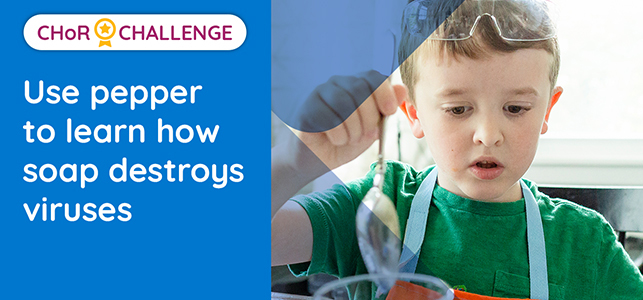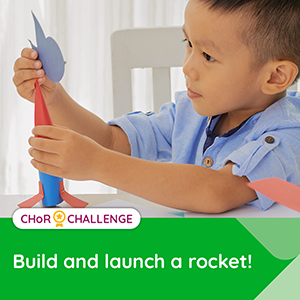Children's Emergency Department is now located in Children's Tower: 1001 E. Marshall Street.
Learn more
Jumping into every puddle they see. Playing with boxes rather than the new toys that came in them. Stopping to smell the flowers, to touch the furry caterpillars, to listen to birds chirping. Asking over and over: why?
The most powerful scientific instrument is a curious mind
That’s kids being kids. But in every case, it’s also children being scientific thinkers. They are making observations and gathering data, posing questions and testing ideas, and recording findings (even if only in their minds) and making connections about our world. By this definition, nearly every child is a budding scientist. After all, the most powerful scientific instrument in the world is a curious mind, and every single child is in possession of an excellent one.
The benefits of encouraging your child’s instinct for science—whether building with blocks in the living room, digging for earthworms in the yard or a passion for biology class when they’re back to school—can shape their lives.
Science builds sensory, vocabulary and analytical skills
Experiencing science in projects and play builds young children’s skills like counting, color and shape recognition, vocabulary and motor coordination. Older kids can perform sophisticated scientific inquiries, learning to analyze and use logic to solve problems. That sounds like serious stuff. But it doesn’t have to be. Because in many ways, science asks us to remain young at heart and to never let go of our childlike habits of wonder and curiosity.
This week’s CHoR challenges focus on science
Put your child’s natural curiosity to work! Here are this week’s suggestions for activities that promote scientific thinking but are also plain old fun. We can’t promise any extra credit, but we encourage your child to share these challenges with their teacher or class during check-ins!
Energy in motion is called kinetic energy—and children are the living embodiments of it! One of the four laws of energy is that it can be neither created nor destroyed, only transferred or changed. The following basic experiment clearly demonstrates that when bouncing balls collide, energy is transferred.
Get two balls of different sizes, such as a basketball and a tennis ball. Ask your child to drop the larger ball from shoulder height. Observe how high the ball bounces, using a reference point such as a wall, fence or the parent’s body. Record your observation. Repeat with the smaller ball. Finally, stack the smaller ball on top of the larger ball (the parent may need to hold the smaller ball still) and drop them together from shoulder height. Observe and record how much higher the smaller ball bounces this time—thanks to the larger ball transferring some of its energy to it. After you’ve discussed the experiment, throw, catch, kick and roll the balls for some fun physical activity—showing that the more energy you transfer into the ball, the further it goes!
CHoR’s new coloring book explains in easy-to-understand terms and pictures what COVID-19 is and how it spreads. Ask your child to read pages 2–3 (or read them to your child) and color the pictures. The coloring book is available here for download. Understanding the science of viruses will help your child use knowledge to reduce anxiety, along with the calm guidance of an adult.
After the coloring book, try this simple experiment to see how soap destroys viruses. Fill a bowl with water and sprinkle a teaspoon of black pepper on it. Because of water tension—water molecules clinging tightly to one another thanks to their atomic bonds—the pepper floats on the surface. In another bowl, put a little liquid soap or soapy water. Explain to your child that the pepper specks floating on the water represent coronaviruses—what causes COVID-19. Ask your child to dip his finger into the bowl. The pepper doesn’t really move, and there’s probably some pepper on his finger when he removes it.
Now ask him to dip his finger in the soap and then put it back in the pepper water. The pepper instantly darts away from his finger to the sides of the bowl! That’s because soap breaks down the water tension which disperses the pepper. Soap molecules have a dual nature—one end is attracted to water and repelled by fats and proteins, the other end is repelled by water and attracted to fats and proteins. Viruses are composed of fats and proteins. So, when a soap molecule encounters a virus, one end buries its way into the virus shell, the other moves the opposite direction, which splits the virus apart like a crowbar.
 Make a paper rocket that can be launched with a straw! NASA’s Jet Propulsion Laboratory has created a video tutorial and a downloadable, printable template for making a rocket with just paper, scissors, tape, pencil and drinking straw. (Note: the project can be done without printing.) Not only is it fun to build and propel your own rocket, but NASA provides tips on improving your design to increase your rocket’s distance.
Make a paper rocket that can be launched with a straw! NASA’s Jet Propulsion Laboratory has created a video tutorial and a downloadable, printable template for making a rocket with just paper, scissors, tape, pencil and drinking straw. (Note: the project can be done without printing.) Not only is it fun to build and propel your own rocket, but NASA provides tips on improving your design to increase your rocket’s distance.
For an enriched learning experience, suggest that your young child watch “Kids vs Planets: The Solar System Explained,” a bedtime “video story” about the solar system produced by Red Cat Reading and available on YouTube. Afterward, ask your child to describe their own imaginary trip to the planets in their straw rocket.
A lifelong habit of inquiry and problem-solving
Encouraging your child’s interest in science is less about raising a botanist, chemist or astrophysicist and more about guiding them toward a life of curiosity; to continue asking why? as their questions lead to answers and insights. By holding onto the joy of discovery, they will develop new problem-solving skills that will take them far.
So, encourage your children’s explorations and experiments —and join them. You may find that thinking like a scientist reawakens your own sense of wonder.